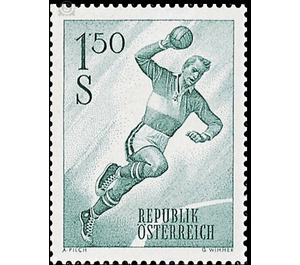Sports - Austria / II. Republic of Austria 1959 - 1.50 Shilling
Theme: Sports & Games
| Country | Austria / II. Republic of Austria |
| Issue Date | 1959 |
| Face Value | 1.50 |
| Color | green |
| Printing Type | Typography |
| Stamp Type | Commemorative |
| Item Type | Stamp |
| Chronological Issue Number | 413 |
| Chronological Chapter | OOS-OE2 |
| SID | 777627 |
| In 73 Wishlists | |
Ball games have been around since ancient times as simple games without special rules. It was not until the 16th century that regulated ball games became more widespread in Europe. Especially students used as a kind of parlor game the ball striking, which also belonged to their regular training and is to be regarded as the predecessor of today's tennis game. For these games, mainly in the residential cities in which there were universities, own sports halls, the so-called Ballhäuser, built. One of these gave his name to the Vienna Ballhausplatz. From England came the football game, which was played but only in the second half of the 19th century according to fixed rules. The present brand motif wants to stand for this further facet of the sport, the experience of the team. The model of belonging together in the service of a common goal fulfills a social function, because it is not least a pedagogically valuable element in the development of every human being. The stamp shows a handball player.


